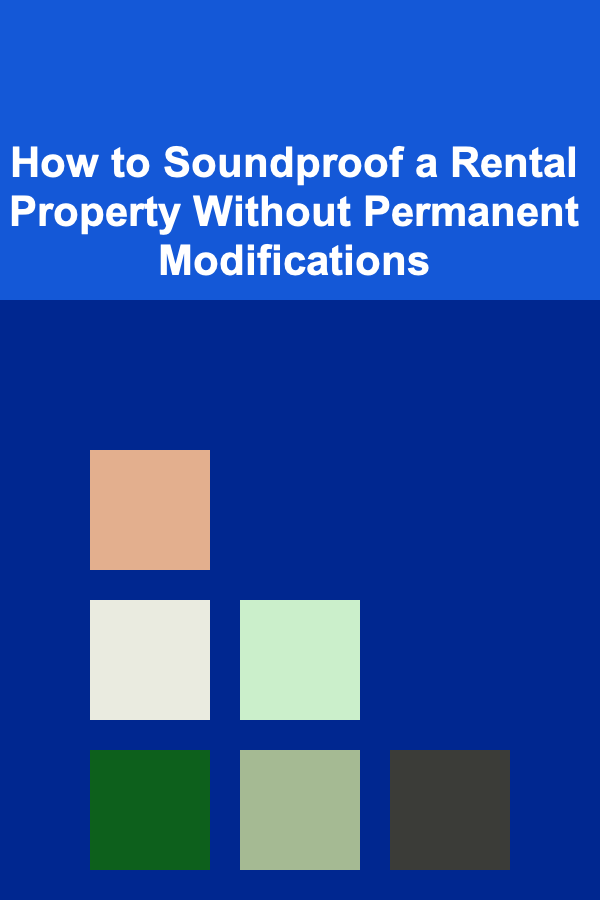
How to Soundproof a Rental Property Without Permanent Modifications
ebook include PDF & Audio bundle (Micro Guide)
$12.99$10.99
Limited Time Offer! Order within the next:

In urban environments, the problem of noise pollution is ever-present. From noisy neighbors and bustling streets to construction sites and traffic, it's no wonder that many renters struggle to enjoy peace and quiet in their homes. Whether you're trying to concentrate on work, watch a movie, or simply sleep soundly, unwanted noise can quickly become a significant source of stress. However, in rental properties, the ability to make permanent changes or modifications is usually restricted by lease agreements and landlords' rules.
While it may seem like soundproofing a rental property is an impossible task, there are several effective, non-permanent ways to block out or minimize sound without making any irreversible alterations. In this article, we will explore various methods that can help you soundproof your rental property without violating the terms of your lease.
Understanding the Basics of Soundproofing
Before diving into specific soundproofing techniques, it's essential to understand how sound travels and why it can be such a challenge to block it out. Sound travels in waves, and when those waves hit a surface, they cause it to vibrate. These vibrations are then transmitted through the material, allowing the sound to pass from one area to another. In a home, sound can travel through walls, ceilings, floors, and windows.
The two primary challenges to address when soundproofing a room are:
- Blocking Sound: Preventing the sound from entering or exiting a room. This typically involves sealing gaps, adding mass, and creating barriers.
- Dampening Vibrations: Reducing the vibrations that occur when sound waves hit surfaces such as walls, floors, and windows. This can be achieved by using sound-absorbing materials or isolating surfaces.
Key Considerations for Renters
For renters, soundproofing presents a unique set of challenges. The most significant factor is the lack of permission to make permanent modifications. Many landlords will not approve major changes like installing thick insulation, replacing windows, or adding drywall to create a sound barrier. Additionally, renters may not want to invest in solutions that would be impossible to take with them when they move.
However, there are several strategies you can employ to address noise problems without making any permanent or irreversible changes. Let's explore these options in detail.
Sealing Gaps and Cracks
One of the simplest and most effective ways to reduce noise infiltration is by addressing any gaps or cracks in the walls, windows, and doors. Even small openings can allow sound to travel in and out of a room, and sealing these gaps can make a noticeable difference.
How to Seal Gaps and Cracks
- Door Sweeps and Draft Stoppers: One of the most common entry points for sound is around doors. Gaps between the bottom of doors and the floor can allow noise to seep in, especially from hallways or common areas. Installing a door sweep (a long strip of material attached to the bottom of a door) can significantly reduce the amount of sound that passes through. Draft stoppers (soft, padded tubes) can also be placed along the bottom of doors to block sound.
- Weatherstripping for Windows and Doors: Weatherstripping is another great tool for reducing noise. These strips of rubber, foam, or silicone are applied along the edges of windows and doors to create an airtight seal. By preventing air and sound from slipping through cracks, weatherstripping helps improve soundproofing.
- Acoustic Sealant: If you have visible cracks or gaps in the walls or around windows, you can use acoustic sealant. This flexible, sound-dampening caulk is designed specifically to block sound transmission. Apply it around window and door frames, as well as in any cracks along the walls. Once dry, it will form a durable barrier that prevents sound from entering.
Add Heavy Curtains or Drapes
If you are dealing with noisy streets, neighbors, or external sounds, adding thick, heavy curtains can help absorb sound and create a quieter living space. Soundproof curtains are designed with dense materials that reduce the amount of sound that passes through your windows.
How to Choose Soundproof Curtains
When shopping for soundproof curtains, look for options made of thick fabrics like velvet, wool, or polyester. These materials have natural sound-absorbing properties and can help to mitigate high-frequency noise, such as voices, car alarms, or footsteps.
- Look for Layered Curtains: Some soundproof curtains are designed with multiple layers, including a sound-dampening layer made from materials like foam or mass-loaded vinyl. The more layers, the better the soundproofing will be.
- Consider the Size and Fit: To ensure that your curtains block as much sound as possible, be sure to choose curtains that are wide enough to cover the entire window and long enough to hang from ceiling to floor. The more coverage the curtains provide, the better they will be at preventing sound from sneaking through.
While curtains won't completely block out noise, they can help to reduce the overall sound levels in a room. For a more significant impact, combine curtains with other soundproofing methods.
Use Rugs and Carpets
Hardwood floors, tile, or concrete floors can amplify sound by reflecting noise throughout a room. One of the easiest ways to reduce this effect is by covering the floors with rugs or carpets. Soft materials like wool, polyester, or shag can absorb sound and prevent it from bouncing off hard surfaces.
How to Soundproof Your Floors
- Thick Area Rugs: Choose thick, dense rugs for the best results. The thicker the rug, the more sound it will absorb. Additionally, rugs with a high pile (tall fibers) tend to absorb more sound than flat rugs. You can use large area rugs in rooms with heavy foot traffic or in spaces where you experience the most noise.
- Carpet Underlays: If you want to further increase the soundproofing properties of your rug, consider adding a carpet underlay or pad beneath it. These underlays are made from dense, sound-absorbing materials like foam or rubber and help to improve the rug's ability to block sound.
- Covering Bare Walls: If your rental property has hard surfaces like concrete or brick walls, adding soft furnishings can help reduce the sound reflections. Wall hangings, upholstered furniture, and even large bookshelves filled with books can all contribute to a quieter environment.
Install Temporary Window Inserts
If the noise from outside is particularly disruptive, you might want to consider installing temporary window inserts. These inserts are removable panels that fit snugly over your existing windows, adding an extra layer of soundproofing without requiring any permanent changes.
How Window Inserts Work
Window inserts are typically made from acrylic or tempered glass, and they create an additional air gap between the insert and the original window. This gap acts as an insulator, preventing sound from traveling through the window. The thicker the material of the insert and the greater the air gap, the more effective the soundproofing will be.
Some companies specialize in custom-made window inserts, while others offer ready-made options that you can install yourself. These inserts are easy to remove and can be stored when not in use, making them a flexible, non-permanent solution.
Soundproofing with Foam Panels
Acoustic foam panels are designed to absorb sound and reduce reverberation within a room. These panels are often used in home studios or office spaces, but they can also be a great option for renters who want to reduce noise levels without making permanent changes.
How to Use Acoustic Foam Panels
- Installation: Acoustic foam panels can be easily attached to walls using adhesive strips or removable mounting hooks. These panels are available in various shapes and sizes and can be placed strategically around the room to absorb sound reflections.
- Placement: To achieve the best results, place the foam panels on walls that face noisy areas, such as shared walls with neighbors or walls adjacent to busy streets. You can also install foam on the ceiling if you're dealing with noise from above.
- Decorative Options: Acoustic foam panels come in various colors and patterns, making it easy to integrate them into your home's décor. Look for options that match your room's aesthetic while providing effective sound absorption.
While foam panels may not block sound completely, they are a cost-effective solution to reduce the echo and reverberation that can amplify noise within a room.
Soundproofing with Furniture and Bookshelves
If you're looking for a creative way to soundproof your rental property, consider rearranging your furniture to create a sound barrier. Heavy furniture can act as a buffer between you and the source of the noise.
How Furniture Can Help
- Bookshelves: Large bookshelves filled with books can be surprisingly effective at dampening sound. Place bookshelves along shared walls or near windows to absorb sound waves.
- Heavy Furniture: Similarly, heavy furniture pieces like sofas, armchairs, and dressers can block noise from passing through walls. Consider positioning them near walls or areas where noise is most disruptive.
- Pillows and Cushions: Add extra cushions or throw pillows to upholstered furniture to increase sound absorption. The more soft materials you have in a room, the better they will help to dampen sound.
Conclusion
Soundproofing a rental property can feel like a daunting task, but with the right strategies, you can create a quieter and more peaceful living space without making permanent modifications. Whether you choose to seal gaps, add heavy curtains, or use acoustic foam panels, these methods can effectively reduce noise infiltration and make your home a more comfortable environment.
Remember, the key to effective soundproofing is a multi-layered approach. By combining various techniques, such as sealing cracks, using soft materials, and adding temporary soundproofing solutions, you can dramatically improve the acoustics of your rental property and enjoy a quieter, more tranquil living space.
Reading More From Our Other Websites
- [Mindful Eating Tip 101] How to Turn Everyday Grocery Shopping into a Mindful Eating Experience
- [Beachcombing Tip 101] How to Safely Transport Fragile Beachcombing Finds in a Shock‑Absorbing Backpack
- [Beachcombing Tip 101] Eco-Friendly Beachcombing: What to Look for (and What to Leave Behind) for a Sustainable Coast
- [Biking 101] Top 5 Bike Chains for Durability and Performance
- [Tiny Home Living Tip 101] Best Legal Considerations and Zoning Tips for Tiny Home Placement
- [Personal Care Tips 101] How to Follow a Hair Care Routine for Strong and Lustrous Hair
- [Metal Stamping Tip 101] How AS9100 Certification Boosts Aerospace Metal Stamping Contracts
- [Organization Tip 101] How to Organize Your Digital Craft Resources
- [Organization Tip 101] How to Set Up a Multi-Functional Fitness Area
- [Organization Tip 101] How to Store Napkins and Table Linens Neatly

10 Clever Tips for Saving Money on Pet Food and Supplies
Read More
How to Make Money Online as an Instagram Growth Manager: 10 Actionable Ideas
Read More
How to Organize Community Outreach Projects Logistically
Read More
How to Prioritize Home Repairs and Upgrades
Read More
How To Use Online Courses for Skill Development
Read More
How To Teach Cultural Sensitivity to Others
Read MoreOther Products

10 Clever Tips for Saving Money on Pet Food and Supplies
Read More
How to Make Money Online as an Instagram Growth Manager: 10 Actionable Ideas
Read More
How to Organize Community Outreach Projects Logistically
Read More
How to Prioritize Home Repairs and Upgrades
Read More
How To Use Online Courses for Skill Development
Read More